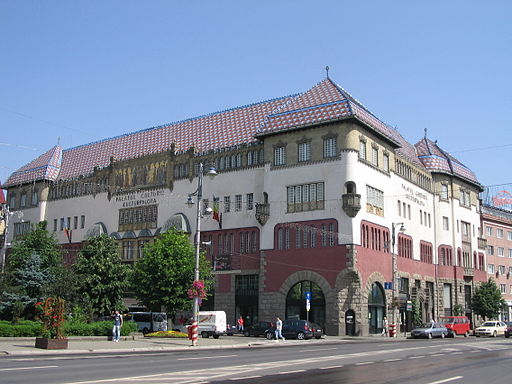Palace of Culture
Original function:
museum
library
dancing / concert hall
Current function:
museum, library, dancing / concert hall
Address:
Piaţa Victoriei (Győzelem tér) 1
Historical Hungarian county:
Maros-Torda
GPS coordinates:
46.5432243909, 24.5579715415
History
In 1907, a bill proposed the establishment of community centres in rural towns to commemorate the fortieth anniversary of the coronation of Franz Joseph. The Palace of Culture was built in the Hungarian Art Nouveau style between 1911 and 1913, during the term of Mayor Bernády György. The Palace of Culture is a significant example of the Hungarian Art Nouveau architectural movement started by Lechner Ödön. The competition for the Palace of Culture was won by Komor Marcell and Jakab Dezső with a three-storey building design, only later to be converted into a four-storey building at the request of Mayor Bernády György. Construction began in 1911 and by 1913 the interior decoration was completed. It housed a concert hall, music school, museum and library. On the ground floor there were shops and a café.
The windows are decorated with scenes from Hungarian sagas. The roof is covered with blue, red and white tiles made by the famous Zsolnay factory. On the third floor, the exterior facade is decorated with a mosaic by Körösfői-Kriesch Aladár entitled "Homage to Hungaria". In the centre, an allegorical female figure of Hungaria is seated on a throne, with the Hungarian crown on her head and a sword in her hand. On either side of the mosaic stands Athena in a helmet. The angel on the left is holding the coat of arms of Marosvásárhely and the angel on the right is holding the coat of arms of King Matthias. On the main facade, the sculptures and reliefs are made of stone and bronze, and are called the national pantheon. The Mirror Room on the first floor has four windows topped with copper-plated half-domes and their parapets are decorated with portraits of Hungarian writers (Kazinczy Ferenc, Tompa Mihály, Kemény Zsigmond, etc.). The parapets of the windows on the second floor are decorated with portraits of great figures of Hungarian literature, science and art carved in stone (including Teleki Sámuel, Bolyai Ferenc, Bolyai János, Mentovich Ferenc). The four bronze reliefs above the gates depict St. Elisabeth of Hungary, Bolyai János and Farkas, Aranka György and Katona József's play Bánk bán set to music by Erkel Ferenc.
The large concert hall on the ground floor can accommodate 800 people. The foyer is 45 metres long. The walls are covered with 12 stained-glass compositions designed by Thorozkai-Wigand Ede and Nagy Sándor for the 1914 San Francisco World's Fair, but history intervened: the First World War broke out. The Mirror Room, the smallest hall in the palace, is a real gem. On the third floor is the Fine Arts Museum, with over a thousand works of art. The library contains more than 1 million volumes.
{"item":"sight","set":{"sightId":2312,"townId":85,"active":2,"name_LO":"","address":"Pia\u0163a Victoriei (Gy\u0151zelem t\u00e9r) 1","mapdata":"1|1889|2876","gps_lat":"46.5432243909","gps_long":"24.5579715415","religion":0,"oldtype":"98,76,92","newtype":"98,76,92","homepage":"http:\/\/palatul-culturii.ro\/hu\/","openinghours":"http:\/\/palatul-culturii.ro\/hu\/vizita\/orar\/","muemlekemlink":"https:\/\/www.muemlekem.hu\/hatareset\/Kulturpalota-Marosvasarhely-1367","csemadoklink":"https:\/\/lexikon.adatbank.transindex.ro\/muemlek.php?id=238","picture":"\u003Ca title=\u0022Rsocol, CC BY-SA 3.0 \u003Chttps:\/\/creativecommons.org\/licenses\/by-sa\/3.0\u003E, via Wikimedia Commons\u0022 href=\u0022https:\/\/commons.wikimedia.org\/wiki\/File:Palatul_Culturii_(Targu_Mures).jpg\u0022\u003E\u003Cimg width=\u0022512\u0022 alt=\u0022Palatul Culturii (Targu Mures)\u0022 src=\u0022https:\/\/upload.wikimedia.org\/wikipedia\/commons\/thumb\/8\/89\/Palatul_Culturii_%28Targu_Mures%29.jpg\/512px-Palatul_Culturii_%28Targu_Mures%29.jpg\u0022\u003E\u003C\/a\u003E","picture_ref":"\u003Ca href=\u0022https:\/\/commons.wikimedia.org\/wiki\/File:Palatul_Culturii_(Targu_Mures).jpg\u0022\u003ERsocol\u003C\/a\u003E, \u003Ca href=\u0022https:\/\/creativecommons.org\/licenses\/by-sa\/3.0\u0022\u003ECC BY-SA 3.0\u003C\/a\u003E, via Wikimedia Commons","name":"Palace of Culture","note":"","history":"In 1907, a bill proposed the establishment of community centres in rural towns to commemorate the fortieth anniversary of the coronation of Franz Joseph. The Palace of Culture was built in the Hungarian Art Nouveau style between 1911 and 1913, during the term of Mayor Bern\u00e1dy Gy\u00f6rgy. The Palace of Culture is a significant example of the Hungarian Art Nouveau architectural movement started by Lechner \u00d6d\u00f6n. The competition for the Palace of Culture was won by Komor Marcell and Jakab Dezs\u0151 with a three-storey building design, only later to be converted into a four-storey building at the request of Mayor Bern\u00e1dy Gy\u00f6rgy. Construction began in 1911 and by 1913 the interior decoration was completed. It housed a concert hall, music school, museum and library. On the ground floor there were shops and a caf\u00e9.@\nThe windows are decorated with scenes from Hungarian sagas. The roof is covered with blue, red and white tiles made by the famous Zsolnay factory. On the third floor, the exterior facade is decorated with a mosaic by K\u00f6r\u00f6sf\u0151i-Kriesch Alad\u00e1r entitled \u0022Homage to Hungaria\u0022. In the centre, an allegorical female figure of Hungaria is seated on a throne, with the Hungarian crown on her head and a sword in her hand. On either side of the mosaic stands Athena in a helmet. The angel on the left is holding the coat of arms of Marosv\u00e1s\u00e1rhely and the angel on the right is holding the coat of arms of King Matthias. On the main facade, the sculptures and reliefs are made of stone and bronze, and are called the national pantheon. The Mirror Room on the first floor has four windows topped with copper-plated half-domes and their parapets are decorated with portraits of Hungarian writers (Kazinczy Ferenc, Tompa Mih\u00e1ly, Kem\u00e9ny Zsigmond, etc.). The parapets of the windows on the second floor are decorated with portraits of great figures of Hungarian literature, science and art carved in stone (including Teleki S\u00e1muel, Bolyai Ferenc, Bolyai J\u00e1nos, Mentovich Ferenc). The four bronze reliefs above the gates depict St. Elisabeth of Hungary, Bolyai J\u00e1nos and Farkas, Aranka Gy\u00f6rgy and Katona J\u00f3zsef's play B\u00e1nk b\u00e1n set to music by Erkel Ferenc.@\nThe large concert hall on the ground floor can accommodate 800 people. The foyer is 45 metres long. The walls are covered with 12 stained-glass compositions designed by Thorozkai-Wigand Ede and Nagy S\u00e1ndor for the 1914 San Francisco World's Fair, but history intervened: the First World War broke out. The Mirror Room, the smallest hall in the palace, is a real gem. On the third floor is the Fine Arts Museum, with over a thousand works of art. The library contains more than 1 million volumes.","town":{"townId":85,"name_HU":"Marosv\u00e1s\u00e1rhely","name_LO":"T\u00e2rgu Mure\u0219","seolink":"marosvasarhely-targu-mures","oldcounty":41,"country":4}},"language":"en","region":"romania","regionid":4,"offer":[],"gallery":false,"album":false}

